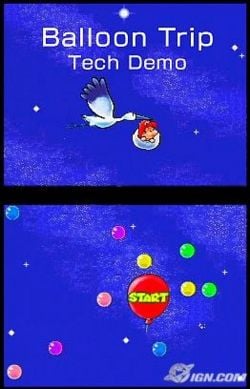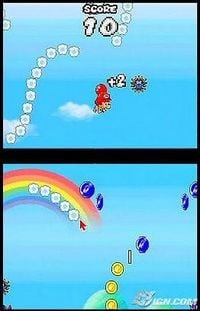Balloon Trip: Difference between revisions
(This article could be merged into Beta Elements or Yoshi Touch & Go, but I think it's OK on its own for now.) |
mNo edit summary |
||
| (68 intermediate revisions by 33 users not shown) | |||
| Line 1: | Line 1: | ||
[[ | {{italic title}} | ||
{{about|the tech demo prototype for [[Yoshi Touch & Go]]|the minigame in [[WarioWare: Smooth Moves]]|[[Balloon Trip (minigame)]]|[[Villager]]'s up special move in the [[Super Smash Bros. (series)|Super Smash Bros. series]]|[[Villager#Balloon Trip|Villager § Balloon Trip]]}} | |||
{{game infobox | |||
|title=Balloon Trip | |||
|image=[[File:BalloonTriptitle.jpg|250px]]<br>'''''Balloon Trip'''''{{'}}s title screen | |||
|developer=[[Nintendo Entertainment Analysis and Development|Nintendo EAD]] | |||
|publisher=[[Nintendo]] | |||
|release=N/A (Shown at E3 2004) | |||
|genre=[[Genre#Platform|Platformer]] | |||
|modes=Single-player | |||
|ratings= | |||
|platforms=[[Nintendo DS]] | |||
|media= | |||
|input={{input|ds=1}} | |||
}} | |||
'''''Balloon Trip''''' was a [[Nintendo DS]] [[tech demo]] shown at {{wp|Electronic Entertainment Expo|E3}} on May 11, 2004.<ref name="tmk">[http://www.themushroomkingdom.net/techdemos.shtml Tech Demos]. ''The Mushroom Kingdom''. Retrieved April 1, 2015</ref> Eventually, it evolved into ''[[Yoshi Touch & Go]]'' in 2005. | |||
'''''Balloon Trip''''' | ==Gameplay== | ||
[[File:BalloonTripscreenshot.jpg|thumb|left|A screenshot of ''Balloon Trip''.]] | |||
''Balloon Trip'' takes its inspiration from the events of <i>[[Super Mario World 2: Yoshi's Island]]</i>, following [[Baby Mario]] as he plummets towards [[Yoshi's Island (location)|Yoshi's Island]] after being knocked away from the [[Stork]] by [[Kamek]]. Three balloons hold Baby Mario aloft in the air, though touching an [[List of enemies|enemy]] removes one of these balloons. If Baby Mario loses all three balloons, he will be abducted by Kamek. The player uses the [[stylus]] to draw clouds across the sky to guide Baby Mario away from enemies and draw circles around enemies to encase them in bubbles, turning them into [[coin]]s. (Later on, in ''Yoshi Touch & Go'', these bubbles could be dragged and thrown with the stylus, though it is unknown whether such a feature existed in ''Balloon Trip''.) The goal of the game is to earn points by collecting as many coins as possible. | |||
If Baby Mario survives the skies for a set amount of time, he will eventually find his way to the ground, where he will be caught by [[Yoshi]] and the player will be congratulated for their score, ending the demo.<ref>Harris, Craig (May 11, 2004). [http://www.ign.com/articles/2004/05/12/e3-2004-hands-on-balloon-trip-ds E3 2004: Hands-On: Balloon Trip DS.] ''IGN''. Retrieved April 1, 2015.</ref> | |||
[[ | ==History and development== | ||
''Balloon Trip'' would eventually be released as the full game ''Yoshi Touch & Go''. While ''Yoshi Touch & Go'' was originally conceived as a [[Nintendo GameCube]] title, [[Shigeru Miyamoto]] believed the game would "have a greater impact" on Nintendo DS.<ref name="nsider">[https://web.archive.org/web/20190310022741/https://www.nsidr.com/archive/the-making-of-the-game-yoshis-touch-and-go The Making of the Game: ''Yoshi Touch & Go''.] ''N-Sider.'' Retrieved April 1, 2015.</ref> The GameCube version of the game - conceived as a puzzle platformer where Yoshi protects Baby Mario - never made it past the conceptual stage, and ''Balloon Trip'' was developed for E3 2004. After the positive reception of the demo, director Hiroyuki Kimura and chief programmer Keizo Ohta felt as if there was "no turning back" from developing the DS project<ref name="nsider"/>. They were given an executive greenlight and a larger development team to expand the concept into a full game for Nintendo DS. | |||
The full game ''Yoshi Touch & Go'' was announced October 7, 2004.<ref name="tmk" /> | |||
Most of <i>Balloon Trip</i>'s basic gameplay would survive into ''Yoshi Touch & Go'', with the most obvious difference between the two games being the addition of the automatically scrolling ground segments, wherein Yoshi protects Baby Mario, which did not exist in ''Balloon Trip''. Smaller differences between the two games include the relocation of [[Fang]]s, which appear in the sky in ''Balloon Trip'', to the ground segments only of ''Yoshi Touch & Go'', and the removal of <i>Balloon Trip</i>'s [[Boo]] enemy (replaced in ''Yoshi Touch & Go'' with [[Toady|Toadies]]). The final game featured new sprites and animations for most characters, as well as a new {{wp|Head-up display|HUD}}. | |||
Most of <i>Balloon Trip</i>'s sounds were used in the final ''Yoshi Touch & Go'' without any changes. | |||
=== | ==Trivia== | ||
*This tech demo's name may have been derived from that of the Balloon Trip [[minigame]] featured in some versions of the previous [[Nintendo]] game ''{{wp|Balloon Fight}}''. | |||
==References== | |||
<references/> | |||
{{Yoshi games}} | |||
{{unreleased media}} | |||
[[Category:Tech demos]] | |||
[[Category:Nintendo DS games]] | |||
[[Category:Games]] | |||
[[Category:Yoshi games]] | |||
[[Category:Platforming games]] | |||
[[Category: | |||
[[Category: | |||
[[Category: | |||
Latest revision as of 01:36, September 28, 2022
- This article is about the tech demo prototype for Yoshi Touch & Go. For the minigame in WarioWare: Smooth Moves, see Balloon Trip (minigame). For Villager's up special move in the Super Smash Bros. series, see Villager § Balloon Trip.
| Balloon Trip | |
|---|---|
 Balloon Trip's title screen | |
| Developer | Nintendo EAD |
| Publisher | Nintendo |
| Platform(s) | Nintendo DS |
| Release date | N/A (Shown at E3 2004) |
| Genre | Platformer |
| Mode(s) | Single-player |
| Input | Nintendo DS:
|
Balloon Trip was a Nintendo DS tech demo shown at E3 on May 11, 2004.[1] Eventually, it evolved into Yoshi Touch & Go in 2005.
Gameplay[edit]
Balloon Trip takes its inspiration from the events of Super Mario World 2: Yoshi's Island, following Baby Mario as he plummets towards Yoshi's Island after being knocked away from the Stork by Kamek. Three balloons hold Baby Mario aloft in the air, though touching an enemy removes one of these balloons. If Baby Mario loses all three balloons, he will be abducted by Kamek. The player uses the stylus to draw clouds across the sky to guide Baby Mario away from enemies and draw circles around enemies to encase them in bubbles, turning them into coins. (Later on, in Yoshi Touch & Go, these bubbles could be dragged and thrown with the stylus, though it is unknown whether such a feature existed in Balloon Trip.) The goal of the game is to earn points by collecting as many coins as possible.
If Baby Mario survives the skies for a set amount of time, he will eventually find his way to the ground, where he will be caught by Yoshi and the player will be congratulated for their score, ending the demo.[2]
History and development[edit]
Balloon Trip would eventually be released as the full game Yoshi Touch & Go. While Yoshi Touch & Go was originally conceived as a Nintendo GameCube title, Shigeru Miyamoto believed the game would "have a greater impact" on Nintendo DS.[3] The GameCube version of the game - conceived as a puzzle platformer where Yoshi protects Baby Mario - never made it past the conceptual stage, and Balloon Trip was developed for E3 2004. After the positive reception of the demo, director Hiroyuki Kimura and chief programmer Keizo Ohta felt as if there was "no turning back" from developing the DS project[3]. They were given an executive greenlight and a larger development team to expand the concept into a full game for Nintendo DS.
The full game Yoshi Touch & Go was announced October 7, 2004.[1]
Most of Balloon Trip's basic gameplay would survive into Yoshi Touch & Go, with the most obvious difference between the two games being the addition of the automatically scrolling ground segments, wherein Yoshi protects Baby Mario, which did not exist in Balloon Trip. Smaller differences between the two games include the relocation of Fangs, which appear in the sky in Balloon Trip, to the ground segments only of Yoshi Touch & Go, and the removal of Balloon Trip's Boo enemy (replaced in Yoshi Touch & Go with Toadies). The final game featured new sprites and animations for most characters, as well as a new HUD.
Most of Balloon Trip's sounds were used in the final Yoshi Touch & Go without any changes.
Trivia[edit]
- This tech demo's name may have been derived from that of the Balloon Trip minigame featured in some versions of the previous Nintendo game Balloon Fight.
References[edit]
- ^ a b Tech Demos. The Mushroom Kingdom. Retrieved April 1, 2015
- ^ Harris, Craig (May 11, 2004). E3 2004: Hands-On: Balloon Trip DS. IGN. Retrieved April 1, 2015.
- ^ a b The Making of the Game: Yoshi Touch & Go. N-Sider. Retrieved April 1, 2015.
